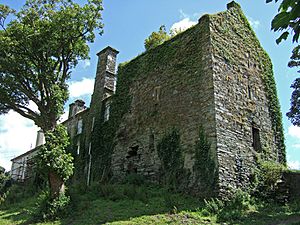Castle Salem, Cork facts for kids
Castle Salem is an old, strong house located near Rosscarbery in County Cork, Ireland. For many years, from about 1660 to the early 1800s, it was home to the Morris family. Later, in 1895, the Daly family bought it. Today, descendants of the Daly family still live there and run it as a guest house.
Contents
History of Castle Salem
When Was Castle Salem Built?
Castle Salem was originally called Benduff Castle. It was likely built around the year 1470. A powerful woman named Catherine Fitzgerald probably built it. She was the daughter of Thomas, the 7th Earl of Desmond. He was a very important person in Ireland at the time.
Benduff Castle means "The Black Peak" in Irish. It's about a mile northwest of Rosscarbery. Unlike many old castles built on high hills, Benduff Castle was in a quiet valley. This hidden spot might have helped protect it from attacks.
The castle was built in a common style for castles in Ireland during the Middle Ages. It had a strong, square main tower with very thick walls. These walls were 11 feet thick! They had small openings for light and for weapons. There were also passages and a stone stairway inside. The castle was once about 70 feet tall. Later, William Morris changed the top and added a slanted roof.
How Did William Morris Get the Castle?
During the time of Oliver Cromwell in Ireland, many lands were taken from their owners. The lands around Benduff Castle belonged to Florence McCarthy, who was a Catholic rebel. His lands were taken by Cromwell's forces.
Around 1660, a man named Captain William Morris was given over 1500 acres of land, including Benduff Castle. He then changed the castle's name to Castlesalem. This name change was made official in 1678.
William Morris and the Quakers
Even though William Morris was a soldier for Cromwell, he became a Quaker in 1656. Quakers are a religious group known for their peaceful beliefs. William was an active and important member of the Quaker community in Ireland.
William Edmondson, another Quaker leader, described William Morris as a talented and influential man. Morris was a captain, a justice of the peace, and a chief treasurer. When he became a Quaker, he lost his military command. He was a wise man and often spoke up for other Quakers who were suffering.
William Morris wrote a short book in 1659 called Tythes No Gospel Ordinance. In this book, he argued that tithes (payments to the church) were unfair. Like many Quakers, this belief caused him trouble with the authorities. He also wrote to the English Parliament in 1659. He challenged them about how Quakers were being treated in Ireland.
William Morris faced difficulties for his beliefs. He was put in prison several times. For example, in 1660, he and other Quakers were jailed in a dirty dungeon for two weeks. Their friends were not allowed to bring them food easily.
George Fox, who founded the Quaker faith, visited Ireland in 1669. He was not always welcome. Paul Morris, William Morris's brother, helped guide George Fox through the streets of Cork. Even the mayor recognized Fox, but he couldn't stop him. This shows how influential the Morris family was.
William Penn's Visits
Another very famous Quaker, William Penn, was a close friend of William Morris. Penn often visited Castle Salem, especially in early 1670. In his diary, called the "Irish Journal," Penn wrote a lot about his time with William Morris. Morris was one of the most important Quakers in the south of Ireland. William Penn respected him greatly and even had him collect rents for him in Cork.
William Penn stayed at or visited Castle Salem many times in 1670. He even wrote parts of his important book, Great Case of Liberty of Conscience Once More Briefly Debated and Defended, while at Castle Salem.
The New House (1682)
William Morris passed away in 1680. After his father's death, his son, Fortunatus Morris, built a new house next to the old castle fortress. This new house was shaped like an 'L', with the old tower at the corner. It was built with small stones and had a tall chimney. From the stairs of the new house, you could step into the old castle through an ancient doorway. Later, a more modern Georgian-style front door was added. The gardens around the castle were very large and beautiful, with ponds and clipped yew trees.
Castle Salem in the 19th Century
The Morris family continued to live in the castle into the early 1800s. In 1815, it was described as the home of William Morris. The description mentioned the old house joined to the ancient castle, standing on a rock in a lovely valley. It also noted many old trees, including a large yew and beech trees.
In 1853, the castle was sold to a Dr. Fitzgibbon for £1,350. By 1870, it was owned by Mrs. Eliza Fitzgibbon.
Patrick Daly bought Castle Salem in 1895 from the Fitzgibbon family. Since then, three generations of the Daly family have farmed the land. Today, Michael and Margaret Daly and their family have partly restored the castle tower. It is still a working farm and offers bed and breakfast stays, as well as tours for visitors.


